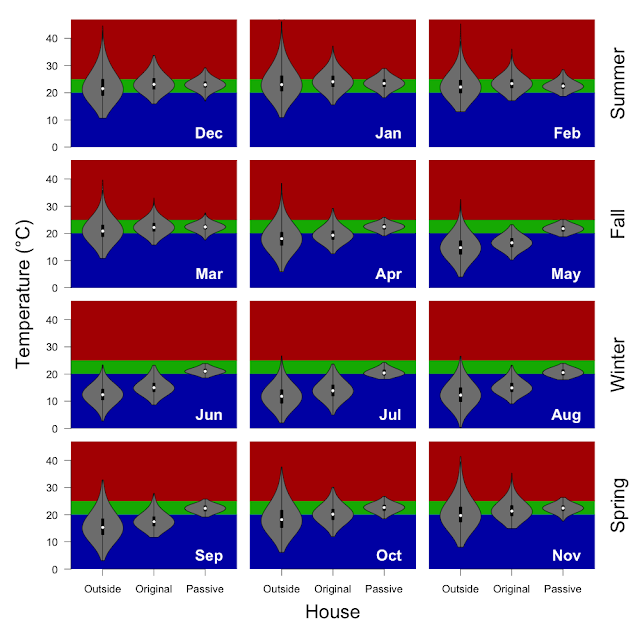2022 Jan
January has been a comparatively cool / wet, so while we have had a fairly easy time staying in the comfort zone, we haven't been generating generating much electricity. The split system was on an automatic mode most of the month (cooling from 10:00 - 18:15) and the HRV was solidly in 'cooling season'. The HRV did a great job of keeping the house in the comfort zone. School holidays, so the kids were at home, so at least one parent was at home... We were mostly at home... again.
Temperature from inside and outside the house as the percentage of hours in 0.5 °C bins. I've scaled the temperature in hopes that they will be comparable across months.
Methods: I have taken the 5 minutely data from the wirelessTag sensors and calculated the median temperature for each hour and determined the proportion of hours falling inside of the 20 - 25 °C target temperature (using the R functions 'aggregate' and 'hist'). Inside includes data from the wirelessTag sensors spread across nearly every room of the house. Outside is the data from the wirelessTag sensors outside near the cubby house and HRV intake. The water wall and door data are not included.Energy production and consumption: 1. total daily consumption daily energy production, 2. daily net energy production, and 3. energy independence (which is the percentage of our daily consumption that is met directly by our solar panels).
Methods: Data are taken from the Enphase Enlighten system. This reports solar generation and electricity consumption as well as import from and export to the grid in 15 minute intervals. The R function 'aggregate' is used to create daily values and the function 'vioplot' to create the plots. The plots show individual days as points, with the vertical black bar covering the middle 50% of the data, the big white circle is the middle of the data (median), the whiskers extend to the farthest points from the median that are not more than 1.5 times the interquartile range, and the grey 'violin' shows the distribution of the datapoints where the narrow portions indicates few datapoints and a wide portion indicates more commonly occurrence... much like a histogram.



